How to Make Kefir
Updated March 05, 2020
How to make milk kefir, a probiotic-rich fermented drink that has lots of health benefits! It’s easy to make at home and so much better than store bought kefir.
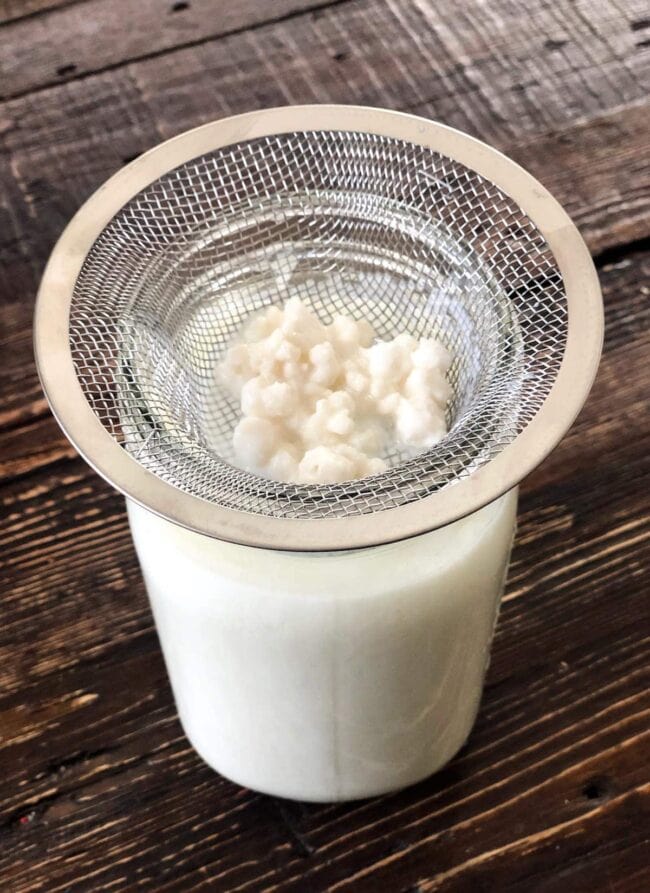
Pin this now to find it later
Pin ItMilk Kefir
I have talked about my love for kefir on Instagram stories and every time I get a ton of questions and requests for me to write a blog post about how to make kefir. Today is the day! We are talking all about kefir! My friend, Tanna, introduced me to kefir. I attended one of her kefir classes and learned SO much. She is the kefir, probiotic queen and I so glad she showed me her kefir ways because I love it! I have been hooked ever since.
So let’s get started. First of all, what is kefir? Kefir is a cultured, fermented beverage made from milk. Kefir has a tart, creamy flavor, kind of similar to buttermilk or plain yogurt.
Benefits of Kefir
Kefir is packed with nutrients and probiotics. It is very helpful for digestion, gut health, a healthy immune system and even mental health. Kefir is also a great source of protein, calcium, and B vitamins.
I have been drinking kefir almost every single day for about a year and I am a believer! I just feel better! My gut is so much happier, I don’t get sick as much…and if I do, I bounce back quickly. I should note, I am not a doctor, I am just sharing my personal experience with kefir. I love it and it is working well for me and my overall health, but please consult your doctor if you have any questions:)
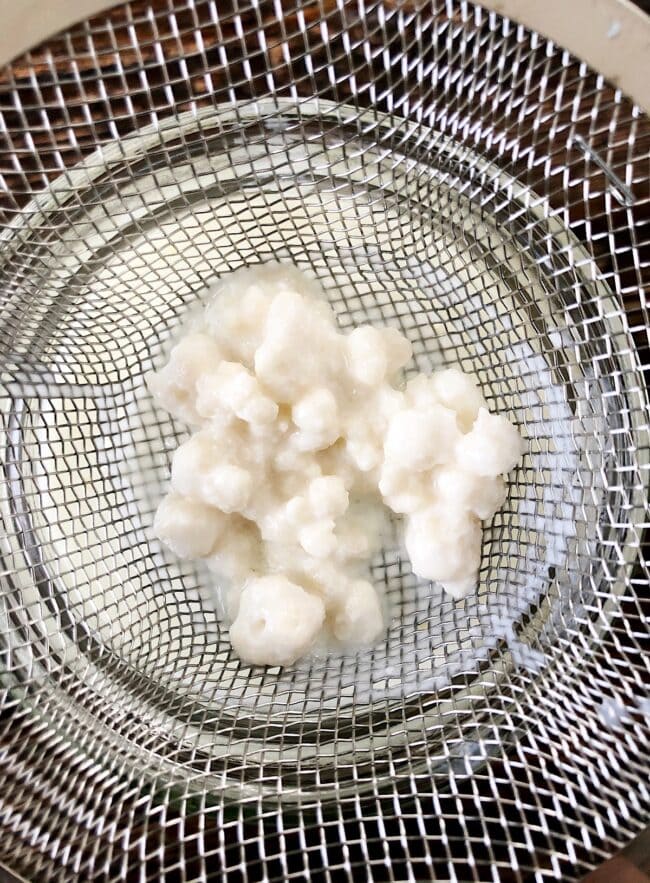
Kefir Grains
To make kefir, you need kefir grains, which are the starter grains. The starter grains are a combination of yeast, milk proteins, and bacteria. They kind of look like cottage cheese:)
Kefir grains are available in some health food stores, as well as online. You can also ask around to see if any of your friends or neighbors have extra kefir grains they want to share. Kefir grains grow with each batch, so people who make their own kefir are usually happy to share their extra grains. I got my grains from my friend Tanna and have since shared with a few friends. It’s fun to share the kefir love:) And kefir grains will grow so you will need to eventually share or you can feed them to chickens or dogs.
You can purchase live kefir grains here. I don’t recommend dried kefir grains, start with live grains for best results.
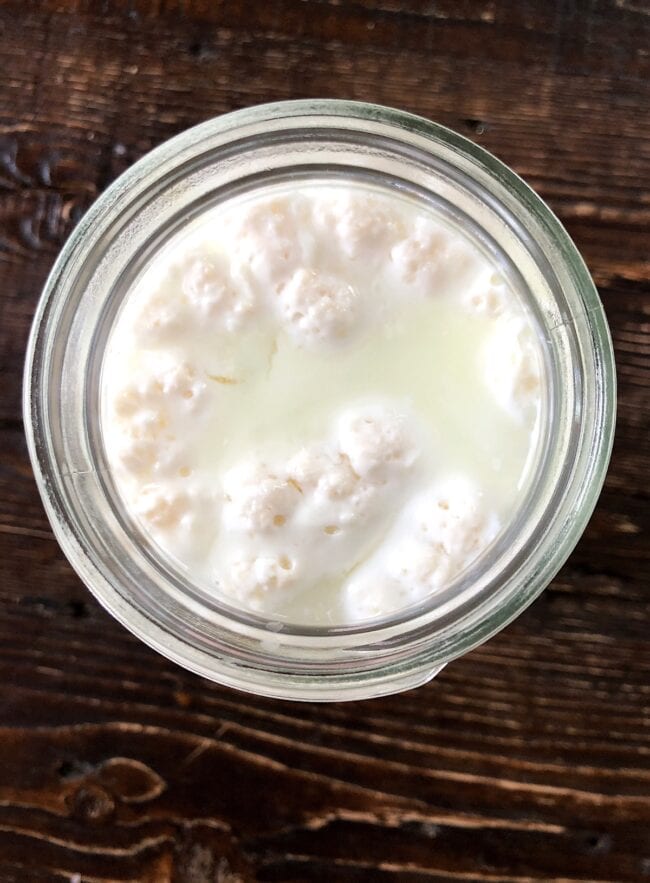
Supplies to Make Kefir
Yes, you can buy kefir at the store but I like to make my own because it doesn’t have any added flavorings or sugars, it’s more affordable, and it really is easy to make!
To make milk kefir, you will need the following:
- Kefir Grains-You will need about 2 teaspoons of kefir grains to get started!
- Glass Jars-Glass won’t react to the acidity of the ferment and glass is BPA free. Use quart size (32 oz) wide mouth glass mason jars. Buy a set so you always have clean jars. DO NOT use the metal lids that come with the jars. Metal should not be used as a culturing vessel or for any item that will have contact with the kefir grains.
- Plastic Lids-Only use plastic lids to cover the jars.
- Stainless Steel or Plastic Mesh Strainer-Only use stainless steel or plastic. Avoid metal strainers and fine mesh strainers, they are too small and make it difficult to strain. I use this strainer.
- Cow’s Milk or Goat’s Milk-Use whole milk, 2% or 1%. Skim milk is not recommended. Ultra-pasteurized or lactose free milk will NOT work. Coconut milk can be used but you have to revitalize the kefir grains in animal milk for 24 hours, every few days. The thickness of your kefir will depend on the type of milk you use. I make my kefir with 1% cow’s milk and it works great!
- Plastic Spoon or Wooden Spoon-never use a metal spoon when dealing with kefir.
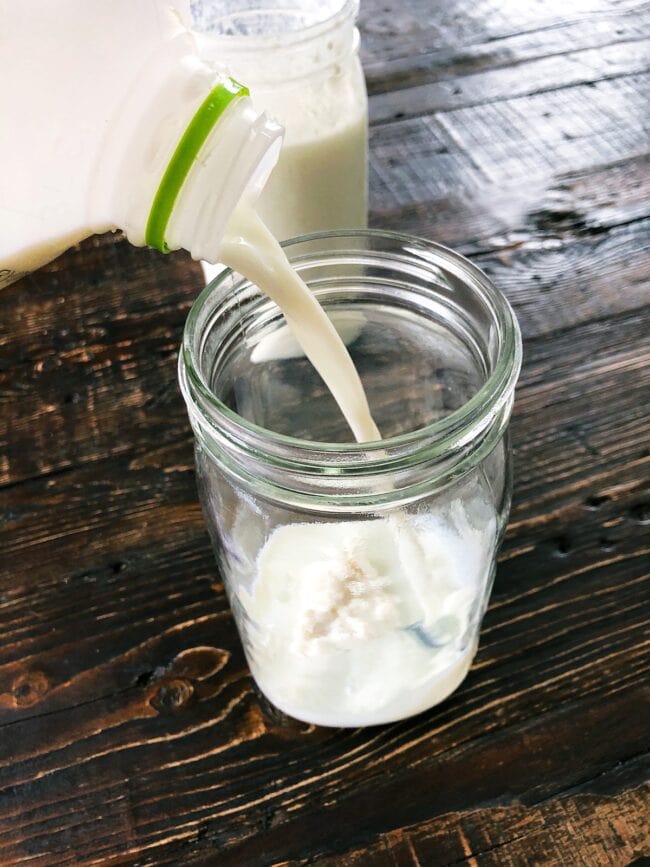
How to Make Milk Kefir
I like to do my “kefir routine” every morning. It only takes about 5 minutes. Let’s get started!
- Put the kefir grains, about 2 teaspoons, into a clean glass jar with about 3 cups fresh milk. Make sure you leave about 1-inch of room at the top of the jar.
- Place a plastic lid on top of the jar, but do not tighten it. You want the lid to be loose on top of the jar.
- Place the jar in a warm place, out of direct sunlight, for 24 hours. I put my jar in a cabinet in our kitchen. You will know your kefir is done when it has slightly thickened and smells fermented. It will also be bubbly, you will be able to tell. It could take a little less than 24 hours or a little longer, it just depends on the temperature of your kitchen. I like to do my kefir routine the same time every morning so it is always right around 24 hours.
- Tighten the lid and shake well. Place a stainless-steel strainer or plastic strainer over a clean jar. Strain the kefir into the jar. To help the thickened milk kefir move through the strainer, you can gently tap the strainer gently against the side of the jar.
- At this point, you can add fresh or frozen fruit if you want to do a second fermentation. I add a half of a banana and then put the lid on tight and let the kefir sit out on the counter for another 2 to 5 hours. This will double the amount of probiotics. If you don’t want to do the second fermentation, you can put the lid on and store the kefir in the refrigerator.
- Now, you start the process over again with the kefir grains you have in the strainer. You don’t need to rinse the kefir grains. Put the kefir grains in a clean jar, add milk, put the lid on (but not tight) and repeat the process.
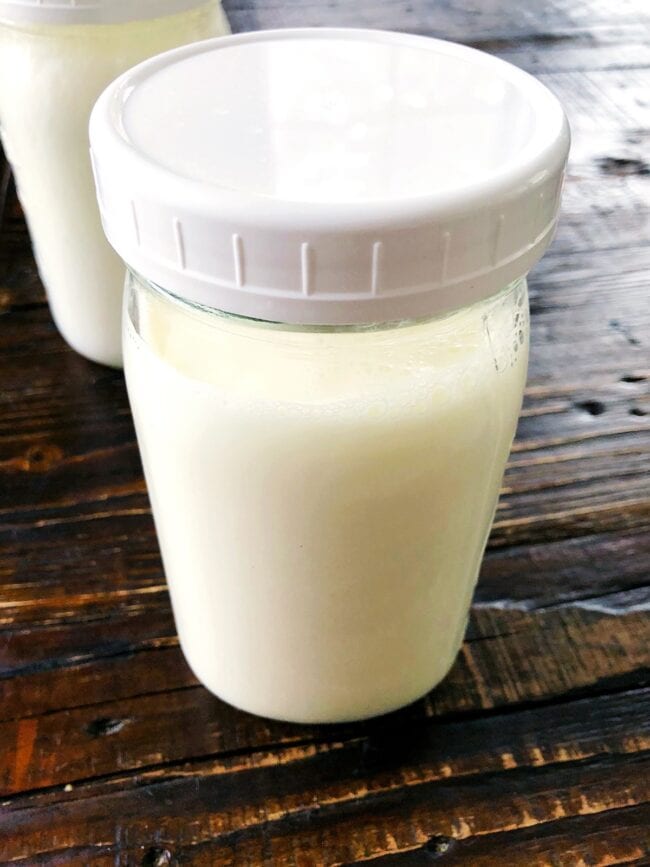
How Long Does Kefir Last in the Fridge
Kefir milk will keep in the refrigerator for up to 3 weeks. I always give it a good shake before using.
If you need to give your kefir a break because you are going out of town or have too much kefir, you can put the grains on pause.
Put the kefir grains in a clean jar with about 3 cups of fresh milk. Put the lid on and place immediately in the refrigerator for up to one week. When you are ready to start making kefir again, put the grains in fresh milk and discard the milk they’ve been sitting in. Start the process over again.
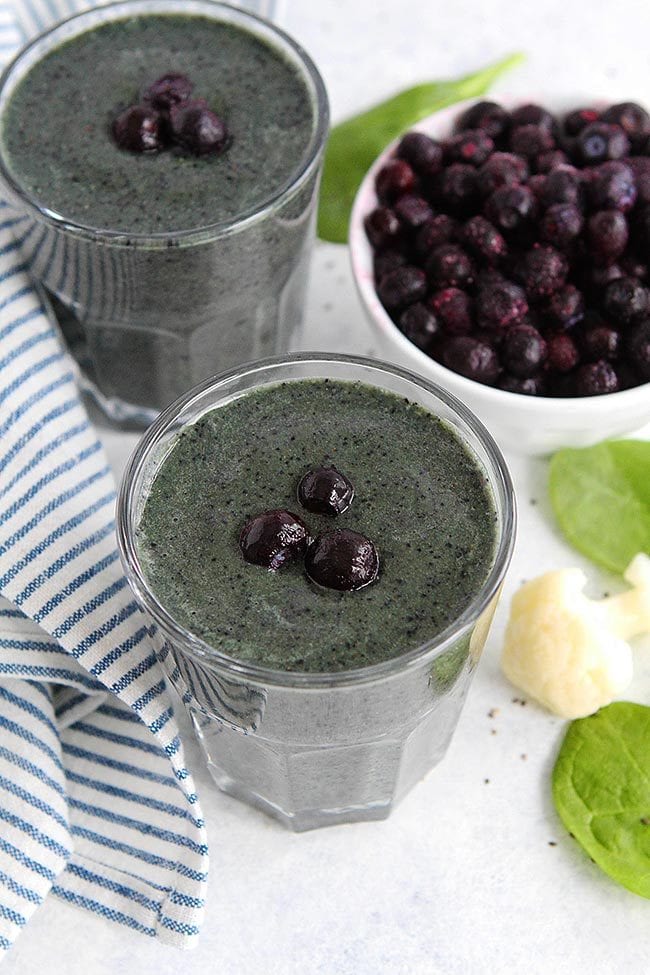
Ways to Use Kefir
Once you start making kefir, you will have A LOT of kefir because you have to make it every day. Our fridge is always full of kefir and our entire family drinks it, even the boys. I make kefir smoothies for us every morning. I also use kefir in as many recipes as possible. I also recommend finding friends to share your kefir with!
And remember, you can always put your kefir on hold if your fridge starts looking like a kefir factory:)
Here are our favorite ways to use kefir:
- Smoothies-my FAVORITE way to use kefir. I make a kefir smoothie every single morning. You can use kefir to replace any milk. My go to is my Secret Ingredient Healthy Smoothie. The boys love it too!
- Kefir Drink-you can drink kefir plain, but it is pretty tart. To sweeten it up a little, add a little fruit and honey or pure maple syrup and blend. If you did the second fermentation, you can just blend the fruit that is in the jar. It will stay good in the fridge.
- Buttermilk Substitute-Use plain kefir in place of buttermilk in recipes. We make kefir biscuits, muffins, pancakes, and waffles all of the time. Note-when you cook with kefir, it will kill the healthy bacteria, but there are still lots of other nutrients and when you have a lot it’s great to use it in recipes so it doesn’t go to waste.
If you aren’t used to drinking kefir, start slowly to allow your body to get used to the extra probiotics, just to be safe:)
If you try making homemade kefir, let me know how it goes! I am seriously a fan!
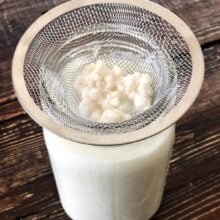
Milk Kefir
Ingredients
- 2 teaspoons kefir grains
- 3 cups fresh milk (cow or goat milk)
Instructions
- Put kefir grains, about 2 teaspoons of grains, into a clean glass jar with about 3 cups fresh milk. Make sure you leave about 1-inch of room at the top of the jar.
- Place a plastic lid on top of the jar, but do not tighten it. You want the lid to be loose on top of the jar.
- Place the jar in a warm place, out of direct sunlight, for 24 hours. I put my jar in a cabinet in our kitchen. You will know your kefir is done when it has slightly thickened and smells fermented.
- Tighten the lid and shake well. Place a stainless-steel strainer or plastic strainer over a clean jar. Strain the kefir into the jar.
- At this point, you can add fresh or frozen fruit if you want to do a second fermentation. I add ½ banana and then put the lid on tight and let the kefir sit out on the counter for another 2 to 5 hours. This will double the amount of probiotics. If you don’t want to do the second fermentation, you can put the lid on and store the kefir in the refrigerator.
- Now, you start the process over again with the kefir grains you have in the strainer. Put the kefir grains in a clean jar, add milk, put the lid on (but not tight) and repeat the process.
Notes
Have you tried this recipe?
Leave a comment below and share a photo on Instagram. Tag @twopeasandpod and hashtag it with #twopeasandtheirpod
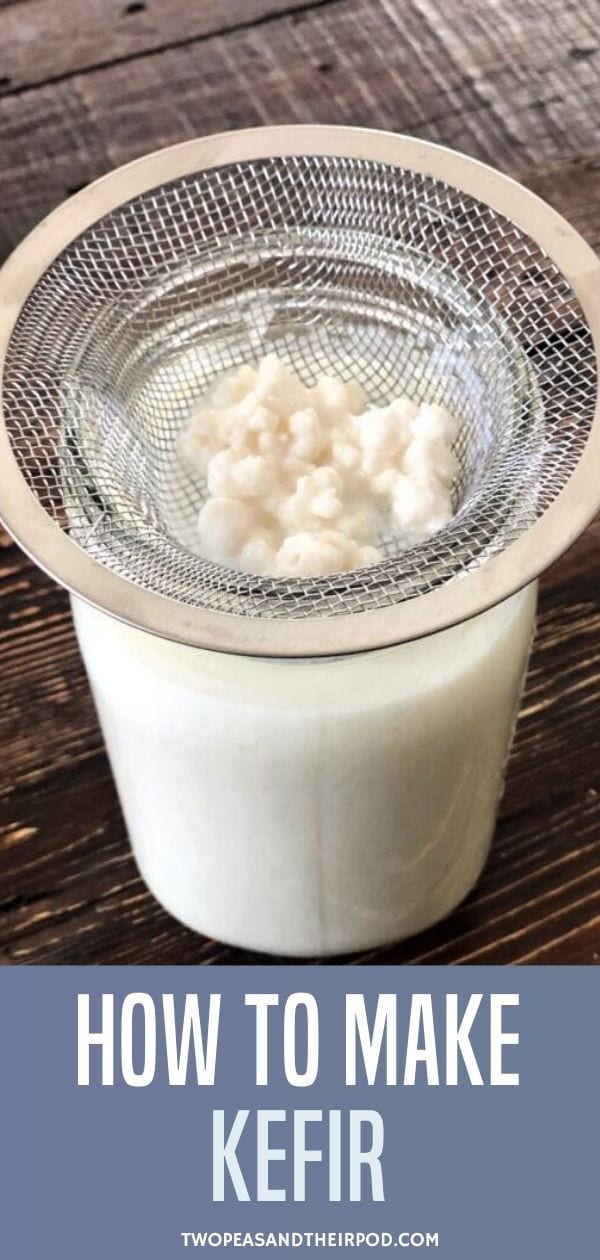
I totally need to make this instead of buying it!
Paige
http://thehappyflammily.com
Hi
Kefir strengthens the immune system.
https://www.canlitv.vin/
I’ve been making milk kefir for several months. I love it! I’ve seen videos of people making it theirs is thick, almost like yogurt. Mine is thick on top while fermenting, but after straining, it is only slightly thicker than milk. I’d like a thicker kefir, any suggestions?
Do you use whole milk? It will be thicker.
Hello. I am having same “issue”. l have some kefír grains l didn’t use for quite a while. The reason is that l prefer nice thick kefír but my grains won’t make it thick no matter what milk l use. The best result l had so far was from store bought milk, however l am buying now only farm milk (full cow, now full goat), still a bit pasteurized. l don’t want buy milk at the the store only for my kefír …. so l am ending up buying kefír at the store instead and keeping my grains in the fridge. Any suggestion , please and thank you. Ina
Thank you for the tutorial! I make kombucha but kefir has intimidated me. I love your idea of adding it to smoothies!
I will have to try kombucha sometime! I love kefir smoothies. I have one almost every morning!
Hi. My kefir does not get thick,and smells really sour. I had better results with dried grains but really want to use the live grains. I want to make it hick like the farmers markets.is that considered kefir cheese. Thx
Great tutorial! I make kefir with my homemade soy milk as I eat a plant based diet. I Often add a teaspoon of coconut sugar to it.
Good to know! Thanks!
Hello Sue Ellen…
COULD YOU PLEASE ADVICE ME HOW KEFIR IS MADE WITH SOYA MILK… AS I AM A VEGANE TOO
APPRECIATE YOUR REPLY.
THANK YOU IN ADVANCE
CAMY BRESLER
very healthy, especially for stomach diseases.
https://www.canlitvizlemeli.com/
Hi Maria
Do you ever eat the kefir grains?
I’ve got a bit of a kefir factory going on over here
What should I do with them?
Thanks!!
I haven’t eaten them. You can give them to dogs or chickens. You can also share with friends if they want to make kefir!
thank you very much.. Kefir is very healthy
https://kralfilm.net
Would it be ok to halve the recipe so you don’t have as much?
You can stop making kefir whenever you have enough. Just put the kefir grains in milk and put in the fridge until you are ready to make it again. See the post for details!
Humans can eat kefir grains too. Some people may not care for their slightly rubbery, chewy texture, but I don’t mind it.
Hi, I am wondering what temperature the milk needs to be. Room temp, warmed, or is it ok to use it straight from the fridge? Thanks.
You can use milk from the fridge to make the kefir.
Hello!How much kefir a day can we drink?Is it bad for diabetics?Thanks for your recipe
I hope you can help me. My kefir was great for the first 2 or 3 weeks. Suddenly it turned very thick and slimy instead of the loose yogurt-like texture it had been. It slides out of the jar like grease and won’t go through the strainer like before. Not palatable to try to drink at all. What could I be doing wrong? Do I need new grains? They have more than doubled in size since I started. Am I not letting it work long enough? It is not separating into any watery whey. HELP!
I haven’t had this happen and I have had the same kefir grains for 2 years. I would recommend getting new grains. The kefir is a little thick until you shake it, but it should thin out and strain just fine. It should never be slimy.
Are you changing the milk daily? I can’t imagine it getting slimy if you do.
Sometimes we forget to add extra milk when our kefir multiplies. You might be adding too little milk now and letting it stand for too long?
It sounds like you’re using too many grains for the amount of milk that you have. Half the amount of kefir grains that you currently have and try that I’m sure your greens are just fine.
If kefir and grains start to get slimy, it’s a good idea to wash the strained grains in some milk. Shake them up in a jar, strain out the milk wash and start using them again. Never use water to wash your grains.
A few years ago a friend gave me some cauliflower like kefir starter. I made it for
awhile, then accidentally froze it in the back
of my fridge. Within the last year I have been making kefir again with a dry kefir
starter from the health food store.
My kefir is working well but it always looks
like cottage cheese instead of cauliflower.
It doesn’t multiply much, but maybe that is
because the small bits go through the sieve.
Is anything g wrong?
Hi Sandy, Since you are using dried kefir from a packet, you will only ever make a batch of drinkable kefir (you said it was more cottage cheese like than like cauliflower). You will never create the cauliflower florette-like Kefir from this so you need to get some of the live grains, reconstitute them, and then after this 24 hr step, make a new batch from the resulting live grains.
Thanks I just got some kefir grains 5hanks for the tips Jeanette
Thanks for the info
Ok this might be a dumb question, but when you add the fruit for the extra fermentation, do you blend up the fruit? If not, do you blend it after it sits a few more hours?
I don’t blend it when I add it. For example, I put the banana in whole and let it sit. You can blend it later.
I started my Kefir last night, almost 24 hours and it is creamy, I strained it and plan a second fermentation and I like the fruit idea.
I can’t wait till tomorrow how the fruit will make out.
HELLO! I am a huge fan of Kefir and I love tartness but mine is coming out SOUR it tastes like straight lemon juice and I add so much sugar and fruit puree and natural fruit or agave syrup to the end product and it still makes me pucker! I know what tart is but mine has gone way beyond that – I use whole milk and keep them fermenting 24 hours as well PLEASE HELP!!!!
Very clear explanation 😉
Sounds delicious. Quick question, Is Kefir a Ketogenic food?bionaze
Me and my wife have dinner tonight, and this one will be an addition to our table. Her doctor diagnosed that she is acidic, I did a little research and kefir will help her to fight the acid in her body. Thank you for sharing this recipe! i hope she’ll like it.
Lovely and simple recipe.
Does toned cow milk work well in the preparation of the kefir?
Thank you so much for your excellent information. I make kefir regularly and have developed the following system. I always have two batches in the works. I ferment about 2-1/2 cups of kefir, then place it in the refrigerator as soon as I see the milk begin to separate slightly at the bottom. I let that batch stay in the refrigerator undisturbed overnight, then strain it just before using it. While that batch is in the refrigerator, I make a second batch so that there is always one ready.
I also culture buttermilk regularly and now mix the strained kefir with buttermilk (thereby creating kefuttermilk); I think that the combination of kefir and buttermilk is delicious.
VERY INTERESTING SUBJET, I WILL TRY…THANK YOU.
How do you make grains when you start making kefir?
You have to buy them or get them from someone who already is making kefir.
If you have too much kefir, puree some fruit and mix with it. Makes fabulous ice lollies.
I use organic half & half to get a much creamier milk kefir. First, I place the milk grains inside a 3.5″ x 4″ cheesecloth tea bag and then drop in with the organic half & half. This not only saves the time of straining the grains from the kefir, but you can immediately start another batch by throwing the same bag of kefir grains with new half & half. Lastly, I do a second fermentation and the results are tangy and delicious. TIP: Once the curds form on top, add two tablespoons of EVO (extra virgin olive oil) for this will improve the second fermentation by sealing the kefir away from oxygen which can inhibit the process and not worry about needing to refrigerate your kefir.
just wanted to let you know that kefir remains drinkable when stored in the fridge for a looong time- with the grains left in-for at least a yr! it just gets bubblier! like pickles or sauerkraut. if you don’t want to make kefir for a while and you forgot to save some milk to store the grains in, you can freeze them. if you can get raw cow or goat milk, that’s the most nutritious
Hello.
Thank you for sharing!
For the second fermentation , how much fruit did you add / cup keffir ? Did you mixed in fruit Pure or whole fruit?
Thank you so much
I add 1/2 large banana. You could do a 1/2 cup of berries.
sorry, I’m new to this….whole or pureed fruit?
Thank you so much!
I use whole fruit.
Muito obrigada pelas dicas
How to increase stability more than 3 weeks .please tell me I want to start my industry….
Hi
Thanks for your great article I take Kiefer for the probiotics, but is a bit too cold for me. How bad is it to heat it up, make it into a warm drink? Thanks ☺️
I like kIFIR
Need to buy Best Quality only
Please guide
Thanks
Thanks Maria! Made my first batch and this morning it looks good. But no grains were strained out. Was my strainer holes too big? Also, the package for the starter had 1 sachet to 1 litre of milk. I wanted to half the batch, so I measured the grains, and the whole sachet was not even 1 1/2 tsp. So the proportions are way different. In the end I used about 3/4 tsp to 2 cups milk. So I am not sure I got that right.
Thank you, I’ve just been searching for information approximately this topic for a long time and yours is the best I’ve found out so far. However, what in regards to the conclusion? Are you certain in regards to the source?|
How many times can you use the same grains
Hi thank you for all the information! How would you suggest saving for longer periods of time? Drying or freezing and what would be the steps to doing so?
Hi Maria,
Thanks so much for your great info.
Can you please tell me if you add all the kefir granules in strainer to the next batch of kefir?
Many thanks
Lynne
Can I use almond milk
Great recipe thanks. My second attempt at making kefir, first time failed and ended up throwing the grains away thinking, I’ll never try this again. Changed my mind, obviously, had a very small amount of grains, less than two teaspoons so adjusted the amount of milk to 1 and 1/2 cups of whole milk, 36 hours later I had the Kefir milk. Made a smoothie with banana and mango, delicious. I don’t mind the tart taste, but did find this a bit too tart, so added a teaspoon of honey. Thanks for this I need to give it a try for problems I have with stomach acid which is making my life a bit of a misery. Hopefully this will make a difference as the side effects of taking PPI’s long term is not good.
If I give some cultured grains to someone who wants to start making their own kefir, how much should I give them (tablespoons), and in how much milk, and in what type of container, please?
I would give them 2 tablespoons in 1 cup of milk in a glass jar.
Dear Maria, I can’t seem to reply to your post, so I hope you see this message. Thank you so much for replying to my query. I need to do this tomorrow, so it was timeous. Much appreciated, Susan.
Should not use any kind of metal when making kefir, i.e., the metal strainer in the photo. Glass or plastic items only …. including utensils.
If the strainer is made of stainless steel you can use it. No problem at all. Taking this in consideration, you rated the recipe unfairly.
My kefir has not grains it is like buttermilk. Is it stil healthy to drink??. I leave some of it for the next plant.
I haven’t tried your recipe yet but I’m currently going thru about 24 ounces of store-bought kefir every 4 days. Your recipe demands that I drink that much each day. My question is, if I halve or even quarter your recipe will it ferment as well?
You can try halving it.
Ugh. I’m new to this, and last night, forgot to strain, and restart my kefir. It sat out for about 36 hours, rather than 24. I immediately stuck it in the fridge, when I realized my mistake. Will it be OK to just carry on, as if it had only been 24 hours, or is it ruined?
Thanks for your very thorough recipe!
That should be fine!
Hi, I made kefir 24h ago following the recipe… but my kitchen is quite cold. There is fermentation -I can see a cluster and some bubbles at the top… but how do I know if the Kefir is thick enough? It feels fully liquid when I shake the bottle gently…
It should bubble up and grow a little. It will separate a little. You have to shake it and then strain it. The kefir is liquid and not too thick.
I followed the directions, however my keifer did not bubble or thicken, plus it’s pretty funky smelling… what did I do wrong?
Thank you for the Kefir recipe and instructions. It worked even though my freeze dried grains were out of date. I’m still searching for a new supply of the Kefir starter. The kefir was great. (In the excitement to make the kefir, I missed the part of the instructions on separating the grains for another batch of kefir.) I look forward to making more. The homemade tastes so much better than the store bought.
I agree, homemade is the BEST!
I made my very first kefir today using raw milk. I used 2 Tbsp and 4 c of milk in a glass jar with a plastic lid. I am a little confused about the 2nd fermentation. If I add 1/2 banana, do I need to mash it or cut it up or just put it in there as is? How does the 2nd fermentation double the probiotics? Or does the fruit have something to do with that?
Don’t mash the banana, just put it in the jar. Yes, the fruit helps!
I bought the kefir grains from Amazon. They must be the dried which you don’t recommend. I also used ultra processed milk. This all because I didn’t see this until after my kefir was made. I guess it came out okay. My question is I see these grains in there. So I can use these grains to make more? Also, my dried grain recipe said to heat the milk to just below boiling. I did this. I let it cool to about 77 deg. F. Your recipe does not say to heat the milk. Why the difference? I have not tasted my concoction yet. It looks like I have a lot of grains there.
You should be able to keep using the grains. I never heat my milk though.
How do I store my grains if I can’t make jefir for a month?
Store them in a jar in the fridge with about 2 cups of milk.
Question.. I was using 3 tablespoons of left over seeds to restart a new batch. Can you over due
The amount? I’m going to cut down to 1 now but, I’m worried that I over did it on the seeds..
Is that even possible? And can to much seeds hurt your stomach?.
Will this work with a carton of milk from the grocery store? I don’t have access to fresh milk.
Yes, you can use milk from the store.